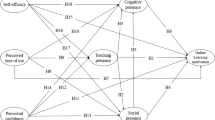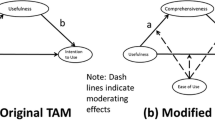Abstract
The online learning has gradually become a notable trend of K-12 education, which requires students’ continuous intention in regard to online learning. Although it is acknowledged that both environmental, technological, and personal factors have the potential to enhance students’ continuous intention toward online learning, there is limited knowledge regarding how these factors interact with each other to affect students’ intention to engage in online learning continuously. Therefore, this study proposed a moderated mediation model to investigate the relationships among K-12 students’ perceived teacher support, perceived technology usefulness, perceived interest, and continuous intention relating to online learning. A total of 1363 valid questionnaires were collected. We found that the extent of teacher support positively predicted students’ intention to continue online learning, but this effect was fully mediated by perceived technology usefulness. Moreover, the mediating path among teacher support, technology usefulness, and continuance intention was moderated by perceived interest. The moderating effect on perceived technology usefulness was higher for students with a low sense of perceived interest than those with a high sense of perceived interest. In light of these findings, it was suggested to establish teacher support that could stimulate technological advantages and pay attention to the cultivation of students’ interest to enhance their continuance intention toward online learning. The limitations and future research directions were discussed.



Similar content being viewed by others
Data Availability
The data that support the findings of this study are available from the corresponding author upon reasonable request.
Change history
17 January 2024
A Correction to this paper has been published: https://doi.org/10.1007/s40299-024-00818-5
References
Abduljalil, K. M., & Zainuddin, Y. (2015). Integrating technology acceptance model and motivational model towards intention to adopt accounting information system. International Journal of Management, Accounting and Economics, 2(5), 346–259.
Alam, S., Mahmud, I., Hoque, S. M. S., Akter, R., & Sohel Rana, S. M. (2022). Predicting students’ intention to continue business courses on online platforms during the Covid-19: An extended expectation confirmation theory. The International Journal of Management Education. https://doi.org/10.1016/j.ijme.2022.100706
Arbaugh, J. B., Cleveland-Innes, M., Diaz, S. R., Garrison, D. R., Ice, P., Richardson, J. C., & Swan, K. P. (2008). Developing a community of inquiry instrument: Testing a measure of the community of inquiry framework using a multi-institutional sample. The Internet and Higher Education, 11(3–4), 133–136. https://doi.org/10.1016/j.iheduc.2008.06.003
Baby, A., & Kannammal, A. (2020). Network Path Analysis for developing an enhanced TAM model: A user-centric e-learning perspective. Computers in Human Behavior. https://doi.org/10.1016/j.chb.2019.07.024
Bandura, A. (1986). Social foundations of thought and action (Vol. 1986). Prentice一Hall.
Bhattacherjee, A. (2001). Understanding information systems continuance: An expectation-confirmation model. MIS Quarterly, 25(3), 351. https://doi.org/10.2307/3250921
Bhattacherjee, A., Perols, J., & Sanford, C. (2015). Information technology continuance: A theoretic extension and empirical test. Journal of Computer Information Systems, 49(1), 17–26. https://doi.org/10.1080/08874417.2008.11645302
Chang, C.-T., Hajiyev, J., & Su, C.-R. (2017). Examining the students’ behavioral intention to use e-learning in Azerbaijan? The general extended technology acceptance model for E-learning approach. Computers & Education, 111, 128–143. https://doi.org/10.1016/j.compedu.2017.04.010
Chiu, C.-M., Chiu, C.-S., & Chang, H.-C. (2007). Examining the integrated influence of fairness and quality on learners’ satisfaction and Web-based learning continuance intention. Information Systems Journal, 17(3), 271–287. https://doi.org/10.1111/j.1365-2575.2007.00238.x
Csikszentmihalyi, M. (1997). Flow and the psychology of discovery and invention (Vol. 39). HarperPerennial.
Davis, F. D. (1985). A technology acceptance model for empirically testing new end-user information systems: Theory and results. Massachusetts Institute of Technology.
Davis, F. D. (1989). Perceived usefulness, perceived ease of use, and user acceptance of information technology. MIS Quarterly, 13(2), 319–340.
Davis, F. D., Bagozzi, R. P., & Warshaw, P. R. (1989). User acceptance of computer technology: A comparison of two theoretical models. Management Science, 35(8), 982–1003. https://doi.org/10.1287/mnsc.35.8.982
Gagné, M., & Deci, E. L. (2005). Self-determination theory and work motivation. Journal of Organizational Behavior, 26(4), 331–362. https://doi.org/10.1002/job.322
Gardner, R. C. (2010). Motivation and second language acquisition: The socio-educational model (Vol. 10). Peter Lang.
Gardner, R. C., & Lambert, W. E. (1972). Attitudes and motivation in second-language learning. Newbury House.
Guo, Z., Xiao, L., Van Toorn, C., Lai, Y., & Seo, C. (2016). Promoting online learners’ continuance intention: An integrated flow framework. Information & Management, 53(2), 279–295. https://doi.org/10.1016/j.im.2015.10.010
Hair, J. F., Black, W., Babin, B., & Anderson, R. (2014). Multivariate data analysis(7th edition). Pearson.
He, S., Jiang, S., Zhu, R., & Hu, X. (2023). The influence of educational and emotional support on e-learning acceptance: An integration of social support theory and TAM. Education and Information Technologies (dordr). https://doi.org/10.1007/s10639-023-11648-1
Hong, J.-C., Hwang, M.-Y., Liu, M.-C., Ho, H.-Y., & Chen, Y.-L. (2014). Using a “prediction–observation–explanation” inquiry model to enhance student interest and intention to continue science learning predicted by their internet cognitive failure. Computers & Education, 72, 110–120. https://doi.org/10.1016/j.compedu.2013.10.004
Huang, C.-H. (2021). Exploring the continuous usage intention of online learning platforms from the perspective of social capital. Information. https://doi.org/10.3390/info12040141
Kong, S. C., & Wang, Y. Q. (2021). The influence of parental support and perceived usefulness on students’ learning motivation and flow experience in visual programming: Investigation from a parent perspective. British Journal of Educational Technology, 52(4), 1749–1770. https://doi.org/10.1111/bjet.13071
Lawson, M. A., & Lawson, H. A. (2013). New conceptual frameworks for student engagement research, policy, and practice. Review of Educational Research, 83(3), 432–479. https://doi.org/10.3102/0034654313480891
Lee, J.-W. (2010). Online support service quality, online learning acceptance, and student satisfaction. The Internet and Higher Education, 13(4), 277–283. https://doi.org/10.1016/j.iheduc.2010.08.002
Lee, Y. C. (2006). An empirical investigation into factors influencing the adoption of an e-learning system. Online Information Review, 30(5), 517–541. https://doi.org/10.1108/14684520610706406
Li, H., & Yu, J. (2019). Learners’ continuance participation intention of collaborative group project in virtual learning environment: An extended TAM perspective. Journal of Data, Information and Management, 2(1), 39–53. https://doi.org/10.1007/s42488-019-00017-8
Li, Y., Duan, Y., Fu, Z., & Alford, P. (2012). An empirical study on behavioural intention to reuse e-learning systems in rural China. British Journal of Educational Technology, 43(6), 933–948. https://doi.org/10.1111/j.1467-8535.2011.01261.x
Lin, W.-S., & Wang, C.-H. (2012). Antecedences to continued intentions of adopting e-learning system in blended learning instruction: A contingency framework based on models of information system success and task-technology fit. Computers & Education, 58(1), 88–99. https://doi.org/10.1016/j.compedu.2011.07.008
Luo, Y., Lin, J., & Yang, Y. (2021). Students’ motivation and continued intention with online self-regulated learning: A self-determination theory perspective. Z Erziehwiss, 24(6), 1379–1399. https://doi.org/10.1007/s11618-021-01042-3
McAuley, E., Duncan, T., & Tammen, V. V. (1989). Psychometric properties of the intrinsic motivation inventory in a competitive sport setting: A confirmatory factor analysis. Research Quarterly for Exercise and Sport, 60(1), 48–58. https://doi.org/10.1080/02701367.1989.10607413
Ong, S. G. T., & Quek, G. C. L. (2023). Enhancing teacher–student interactions and student online engagement in an online learning environment. Learning Environments Research. https://doi.org/10.1007/s10984-022-09447-5
Reuge, N., Jenkins, R., Brossard, M., Soobrayan, B., Mizunoya, S., Ackers, J., & Taulo, W. G. (2021). Education response to COVID 19 pandemic, a special issue proposed by UNICEF: Editorial review. International Journal of Educational Development, 87, 102485. https://doi.org/10.1016/j.ijedudev.2021.102485
Riegel, C., & Mete, R. (2017). Educational technologies for K-12 learners: What digital natives and digital immigrants can teach one another. International Society for Educational Planning, 24(4), 49–58.
Roca, J. C., & Gagné, M. (2008). Understanding e-learning continuance intention in the workplace: A self-determination theory perspective. Computers in Human Behavior, 24(4), 1585–1604. https://doi.org/10.1016/j.chb.2007.06.001
Ryan, R. M., & Deci, E. L. (2000). Intrinsic and extrinsic motivations: Classic definitions and new directions. Contemporary Educational Psychology, 25(1), 54–67. https://doi.org/10.1006/ceps.1999.1020
Ryan, R. M., Koestner, R., & Deci, E. L. (1991). Ego-involved persistence: When free-choice behavior is not intrinsically motivated. Motivation and Emotion., 15(3), 185–205. https://doi.org/10.1007/bf00995170
Sharif Abbasi, M., Hussain Chandio, F., Fatah Soomro, A., & Shah, F. (2011). Social influence, voluntariness, experience and the internet acceptance. Journal of Enterprise Information Management, 24(1), 30–52. https://doi.org/10.1108/17410391111097410
Shea, P., & Bidjerano, T. (2010). Learning presence: Towards a theory of self-efficacy, self-regulation, and the development of a communities of inquiry in online and blended learning environments. Computers & Education, 55(4), 1721–1731. https://doi.org/10.1016/j.compedu.2010.07.017
Shih, H.-P. (2004). Extended technology acceptance model of internet utilization behavior. Information & Management, 41(6), 719–729. https://doi.org/10.1016/j.im.2003.08.009
Sørebø, Ø., Halvari, H., Gulli, V. F., & Kristiansen, R. (2009). The role of self-determination theory in explaining teachers’ motivation to continue to use e-learning technology. Computers & Education, 53(4), 1177–1187. https://doi.org/10.1016/j.compedu.2009.06.001
Sukendro, S., Habibi, A., Khaeruddin, K., Indrayana, B., Syahruddin, S., Makadada, F. A., & Hakim, H. (2020). Using an extended technology acceptance model to understand students’ use of e-learning during Covid-19: Indonesian sport science education context. Heliyon, 6(11), e05410. https://doi.org/10.1016/j.heliyon.2020.e05410
Sun, J.C.-Y., & Rueda, R. (2012). Situational interest, computer self-efficacy and self-regulation: Their impact on student engagement in distance education. British Journal of Educational Technology, 43(2), 191–204. https://doi.org/10.1111/j.1467-8535.2010.01157.x
Venkatesh, V., & Bala, H. (2008). Technology acceptance model 3 and a research agenda on interventions. Decision Sciences, 39(2), 273–315. https://doi.org/10.1111/j.1540-5915.2008.00192.x
Venkatesh, V., & Davis, F. D. (2000). A theoretical extension of the technology acceptance model: Four longitudinal field studies. Management Science, 46(2), 186–204. https://doi.org/10.1287/mnsc.46.2.186.11926
Venkatesh, V., Morris, M. G., Davis, G. B., & Davis, F. D. (2003). User acceptance of information technology: Toward a unified view. MIS Quarterly, 27(3), 425–478. https://doi.org/10.2307/30036540
Wang, S.-K., Hsu, H.-Y., Campbell, T., Coster, D. C., & Longhurst, M. (2014). An investigation of middle school science teachers and students use of technology inside and outside of classrooms: Considering whether digital natives are more technology savvy than their teachers. Educational Technology Research and Development, 62(6), 637–662. https://doi.org/10.1007/s11423-014-9355-4
Yan, M., Filieri, R., & Gorton, M. (2021). Continuance intention of online technologies: A systematic literature review. International Journal of Information Management. https://doi.org/10.1016/j.ijinfomgt.2021.102315
Yao, Y., Wang, P., Jiang, Y., Li, Q., & Li, Y. (2022). Innovative online learning strategies for the successful construction of student self-awareness during the COVID-19 pandemic: Merging TAM with TPB. Journal of Innovation & Knowledge. https://doi.org/10.1016/j.jik.2022.100252
Yu, Z., Xu, W., & Sukjairungwattana, P. (2022). Motivation, learning strategies, and outcomes in mobile english language learning. The Asia-Pacific Education Researcher. https://doi.org/10.1007/s40299-022-00675-0
Zhang, M., Liu, Y., Yan, W., & Zhang, Y. (2016). Users’ continuance intention of virtual learning community services: The moderating role of usage experience. Interactive Learning Environments, 25(6), 685–703. https://doi.org/10.1080/10494820.2016.1172242
Acknowledgements
The authors declare that they have no conflict of interest. This work was financially funded by the Collaborative Innovation Center for Informatization and Balanced Development of K-12 Education by MOE and Hubei Province (Grant Number xtkjrh2021-06).
Author information
Authors and Affiliations
Corresponding author
Additional information
Publisher's Note
Springer Nature remains neutral with regard to jurisdictional claims in published maps and institutional affiliations.
Appendix A: Questionnaire
Appendix A: Questionnaire

Rights and permissions
Springer Nature or its licensor (e.g. a society or other partner) holds exclusive rights to this article under a publishing agreement with the author(s) or other rightsholder(s); author self-archiving of the accepted manuscript version of this article is solely governed by the terms of such publishing agreement and applicable law.
About this article
Cite this article
Yan, Y., Zuo, M., Duan, P. et al. What Drives K-12 Students’ Continuous Intention Toward Online Learning: A Moderated Mediation Model of Integrating Interest, Teacher, and Technical Stimuli. Asia-Pacific Edu Res 33, 693–703 (2024). https://doi.org/10.1007/s40299-023-00766-6
Accepted:
Published:
Issue Date:
DOI: https://doi.org/10.1007/s40299-023-00766-6




